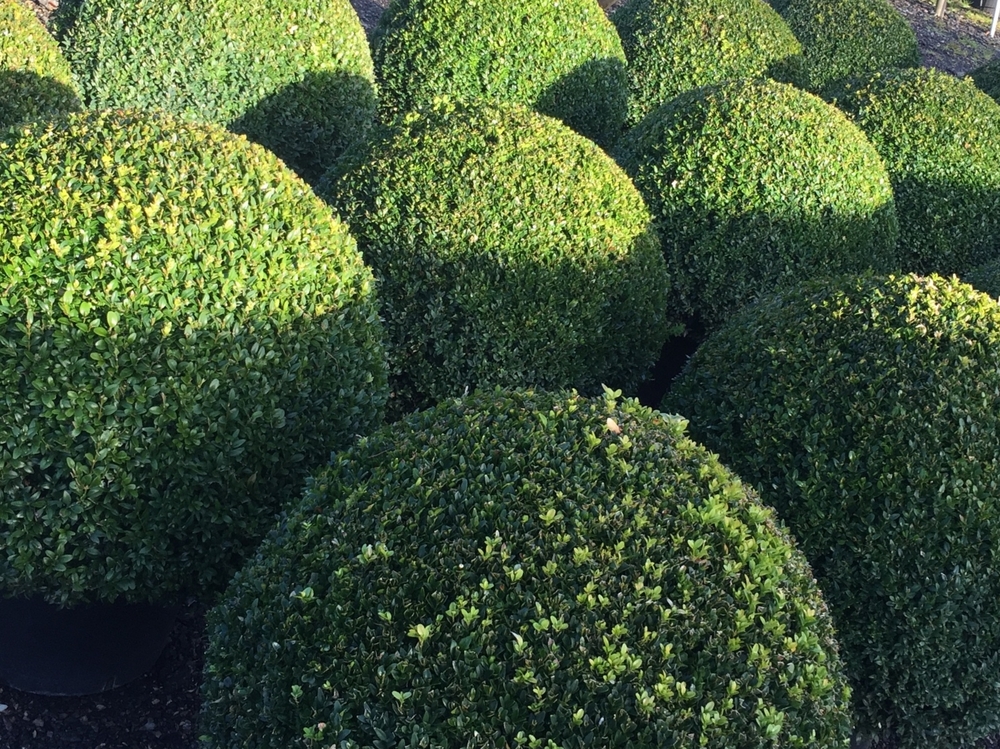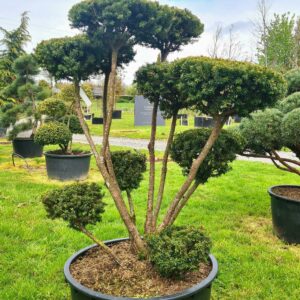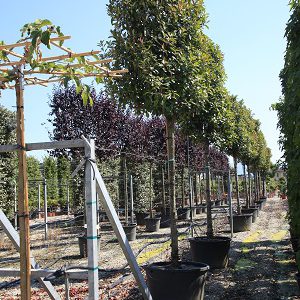Buxus sempervirens / Box Balls
Price range: €30.00 through €145.00
Frequently Bought Together



Description
Quick Facts
- Common Name: Common Box, English Box, Boxwood (clipped ball form)
- Botanical Name: Buxus sempervirens (topiary ball)
- Plant Type: Evergreen shrub (clipped topiary)
- Mature Height: Variable (maintained at clipped size: 30cm, 40cm, 50cm, 60cm+ diameter)
- Mature Spread: Variable (maintained at clipped size: 30cm, 40cm, 50cm, 60cm+ diameter)
- Flowering Period: April to May (flowers insignificant)
- Flower Colour: Pale green-yellow (not ornamentally significant)
- Foliage: Dense small glossy dark green evergreen leaves
- Hardiness: RHS H6 (hardy throughout UK and Ireland)
- Soil Requirements: Well-drained, moderately fertile soil
- Aspect: Full sun to partial shade
- Maintenance: Moderate (requires regular clipping to maintain shape)
Description
Experience the breathtaking beauty of Buxus sempervirens Box Balls, one of the most spectacular and timeless evergreen topiary forms for gardens, where perfectly clipped spherical shapes, dense glossy dark green foliage, and classic formal elegance combine to create stunning displays of architectural presence and year-round structure that bring centuries of garden heritage and exceptional versatility with remarkable adaptability making this perfect for adding formal elegance, architectural focal points, and reliable evergreen structure to formal gardens, container plantings, parterres, and contemporary landscapes where timeless sophistication and sculptural presence are essential. These exceptional topiary specimens offer remarkable qualities—perfectly clipped spherical forms creating elegant architectural presence and living sculpture, dense glossy dark green evergreen foliage creating year-round colour and polished appearance, outstanding versatility suitable for formal gardens, contemporary landscapes, container plantings, and traditional parterres, exceptional longevity with specimens lasting decades or even centuries with proper care, and remarkable adaptability thriving in wide range of conditions throughout UK and Ireland including sun, shade, containers, and challenging sites, making this one of the most rewarding and reliable choices for adding formal elegance, sculptural presence, and year-round evergreen structure to gardens.
Throughout the seasons, these captivating topiary specimens display spectacular year-round interest—the foliage is the primary ornamental feature providing constant presence in all seasons. The foliage consists of small oval to elliptical leaves measuring 1.5-3cm long and 0.5-1cm wide arranged in opposite pairs creating dense coverage. The leaves are glossy dark green to deep green on upper surfaces with high gloss creating polished lustrous effect. The undersides are paler green. The foliage is densely packed creating substantial coverage—the tight branching structure and small leaves allow for precise clipping creating crisp clean edges and perfect spherical forms. The foliage remains evergreen year-round providing constant structure and colour—in winter, the glossy dark green foliage remains attractive providing reliable presence when many gardens are dormant. In very cold winters, foliage may develop slight bronze tints, particularly in exposed positions, but returns to dark green in spring. The foliage has distinctive pleasant aromatic scent when brushed or clipped. In spring (April-May), the plant produces small insignificant pale green-yellow flowers clustered in leaf axils—these are not ornamentally significant and are typically removed during clipping. The growth habit is naturally dense and compact with multiple stems arising from base creating bushy form. When left unclipped, box grows into rounded shrub 2-4m tall, but when trained as topiary balls, specimens are maintained at desired diameter (commonly 30cm, 40cm, 50cm, 60cm, or larger) through regular clipping. The clipped spherical form creates perfect geometric shapes—living sculptures providing architectural presence. The tight dense growth and small leaves make box ideal for topiary as it responds well to clipping, maintains crisp edges, and fills in quickly. The overall effect is elegant, formal, and timelessly sophisticated—like having perfectly sculpted green spheres creating architectural focal points and classical elegance with year-round evergreen presence.
Native to Europe, North Africa, and western Asia including southern England where Buxus sempervirens grows wild in chalk woodlands, this species has been cultivated in European gardens for over 2,000 years and is one of the most important plants in garden history. The genus name Buxus comes from the Greek ‘pyxos’ (box tree). The species name ‘sempervirens’ means “always green,” referring to the evergreen foliage. Box has been used for topiary, hedging, and parterres since Roman times and became particularly important in Renaissance Italian gardens, French formal gardens (notably Versailles), and English knot gardens and parterres. Box topiary balls represent centuries of horticultural tradition and remain one of the most popular and versatile topiary forms. Box is specifically valued for exceptional dense growth allowing precise clipping and crisp edges, small glossy evergreen foliage creating polished appearance year-round, outstanding longevity with specimens lasting decades to centuries, remarkable shade tolerance thriving in positions where few evergreens succeed, and versatility suitable for formal gardens, contemporary landscapes, and container plantings. Hardy to RHS H6, this robust evergreen thrives throughout UK and Ireland with complete reliability, tolerating cold winters (to -20°C), exposed positions, shade, urban pollution, and challenging conditions. Slow to moderate growth rate when unclipped (10-15cm annually), but maintained at desired size through regular clipping. Particularly valuable for perfectly clipped spherical forms creating architectural focal points, dense glossy dark green evergreen foliage providing year-round structure, outstanding versatility for formal and contemporary gardens, exceptional shade tolerance, and timeless classical elegance. The sculptural form and year-round presence make this outstanding for formal gardens, container plantings, and architectural features. IMPORTANT NOTE: Box blight (fungal diseases Cylindrocladium buxicola and Volutella buxi) and box tree caterpillar (Cydalima perspectalis) are serious threats—see Seasonal Care for prevention and management.
Create stunning compositions by planting in pairs flanking doorways, gates, or pathways where the matching spheres create formal symmetry and elegant emphasis, using in rows or formal arrangements creating rhythmic patterns and classical structure, or positioning in containers (terracotta, stone, lead, contemporary) creating spectacular portable displays for patios, entrances, balconies, and roof gardens. Exceptional in formal parterres and knot gardens where the clipped forms create geometric patterns and traditional elegance, in contemporary minimalist gardens where the sculptural spheres provide architectural presence and clean lines, or as focal points in mixed borders where the evergreen structure anchors seasonal plantings. Works beautifully combined with other formal elements—clipped box hedging, yew topiary, or pleached trees for layered classical elegance, combined with traditional formal plants (roses, lavender, santolina, rosemary) for classic English garden character, or combined with contemporary perennials (grasses, Verbena bonariensis, Echinacea, Sedum) for modern formal-informal contrast. Also magnificent underplanted with seasonal bedding (tulips, violas, begonias) for changing colour, combined with other topiary forms (cones, spirals, pyramids) for varied sculptural interest, or positioned in gravel gardens where the evergreen spheres create focal points against neutral backgrounds. Perfect for adding formal elegance, sculptural presence, and year-round evergreen structure to formal gardens, container plantings, parterres, and contemporary landscapes. Timeless sophistication and living sculpture!
Caragh Garden Notebook
Planting: Space according to desired effect—for flanking pairs, position symmetrically; for rows, space 60cm-1m apart (depending on ball size) for individual specimens, or closer (40-50cm) for more continuous effect. Plant container-grown specimens year-round, though spring (March-May) or autumn (September-October) is ideal for best establishment. Choose position in full sun to partial shade—thrives in wide range of light conditions including considerable shade (one of the best evergreens for shade). Shelter from cold drying winds in exposed positions—box tolerates wind but may suffer foliage browning in very exposed sites. Thrives in range of garden situations. Dig generous planting hole twice width of root ball and same depth. Box prefers well-drained soil—avoid waterlogged conditions. Incorporate organic matter (well-rotted compost, leaf mould) into backfill soil to improve moisture retention and fertility. Plant at same depth as in container, ensuring root ball is level with surrounding soil. Backfill carefully, firming gently. Water thoroughly after planting. Apply 5-8cm mulch around base, keeping mulch clear of stem (5cm gap)—avoid mulching right up to stems as this can encourage box blight. Water regularly during first growing season. IMPORTANT: Good air circulation around plants helps prevent box blight—avoid overcrowding and ensure adequate spacing.
Soil Preparation: Prefers well-drained, moderately fertile soil for best growth. Tolerates wide pH range from slightly acidic to alkaline (pH 6.5-8.0)—particularly thrives on alkaline chalky soils. Thrives in wide range of soil types including sandy, loamy, clay, and chalky soils provided drainage is adequate. Requires well-drained soil—waterlogged conditions encourage root rot and box blight. Thrives in moderately fertile soils—excessively rich soils can cause soft lush growth more susceptible to disease. Improve heavy clay soils by incorporating organic matter and grit to improve drainage. Improve light sandy soils by adding compost to improve moisture retention. Mulch annually in spring with 5-8cm layer of organic matter around base, keeping mulch clear of stems (5cm gap). Keep mulch away from stems to promote air circulation and reduce disease risk. Best growth occurs in full sun to partial shade with well-drained, moderately fertile soil—these conditions produce the most compact growth and healthiest foliage.
Container Growing: Excellent for container growing—one of the finest evergreens for containers! Use containers with excellent drainage holes (size depends on ball diameter: minimum 40cm container for 30cm ball, 50cm container for 40cm ball, etc.—container should be 10-15cm larger than ball diameter), soil-based compost (John Innes No. 2 or No. 3), and position in full sun to partial shade. Water regularly during growing season—never allow compost to dry out completely, but avoid waterlogging. Feed in spring and midsummer with slow-release balanced fertiliser or liquid feed. Clip twice annually to maintain shape (see Seasonal Care). Top-dress annually with fresh compost. Repot every 3-5 years in spring using fresh compost and same size or slightly larger container. Perfect for creating formal elegance on patios, balconies, and entrances! IMPORTANT: Container-grown specimens are more vulnerable to box blight—ensure excellent drainage and air circulation.
Seasonal Care: CLIPPING (ESSENTIAL): Clip twice annually to maintain perfect spherical shape—first clip in late spring (May-June) after spring growth flush, second clip in late summer (August-September) after summer growth flush. Use sharp hand shears or topiary shears for best results—avoid hedge trimmers which can damage foliage. Clip on dry days when foliage is dry (wet foliage spreads box blight). Clip to maintain desired size and perfect spherical form—step back frequently to assess shape from all angles. Remove all clippings promptly and dispose of (do not compost)—leaving clippings around base can encourage disease. CRITICAL BOX BLIGHT PREVENTION: Box blight (fungal diseases) is serious threat causing rapid foliage browning and defoliation. Prevention measures: ensure excellent drainage and air circulation, avoid overhead watering (water at base only), clip on dry days with dry foliage, sterilise tools between plants (use disinfectant or methylated spirits), remove and destroy any infected material immediately, avoid high-nitrogen fertilisers causing soft growth, and consider preventative fungicide sprays in spring and autumn. Watch for symptoms: brown patches, rapid defoliation, black streaking on stems. If infection occurs, remove affected material immediately, sterilise tools, and consider replacing with box blight-resistant alternatives (Ilex crenata, Euonymus japonicus ‘Microphyllus’). BOX TREE CATERPILLAR: Invasive pest causing rapid defoliation. Watch for webbing and green caterpillars (March-October). Remove by hand if possible or use biological control (Bacillus thuringiensis) or appropriate insecticide. Check plants regularly during growing season. Apply balanced slow-release fertiliser in spring. Mulch annually in spring, keeping mulch clear of stems. Water during prolonged dry spells, particularly container specimens. The perfectly clipped spherical forms and glossy evergreen foliage are stunning when healthy!
Propagation: Can be propagated from semi-ripe cuttings taken in late summer (August-September)—take 10-15cm cuttings from current season’s growth, remove lower leaves, dip in rooting hormone, and insert into free-draining compost mixed with grit. Maintain cool humid conditions. Rooting takes 8-16 weeks. Home gardeners can propagate successfully, though nursery-grown clipped specimens provide immediate impact and save years of training.
These spectacular beauties are absolutely breathtaking—timeless formal elegance and living sculpture! Those perfectly clipped spherical forms are absolutely stunning—architectural focal points and classical sophistication! Dense glossy dark green evergreen foliage creating year-round colour and polished appearance. Outstanding versatility—perfect for formal gardens, contemporary landscapes, container plantings, and parterres! Exceptional shade tolerance—thrives where few evergreens succeed! Available in multiple sizes (commonly 30cm, 40cm, 50cm, 60cm+ diameter). Hardy (RHS H6)—completely reliable throughout UK and Ireland! Slow to moderate growth when unclipped, but maintained at desired size through regular clipping. ESSENTIAL MAINTENANCE: Clip twice annually (May-June and August-September) to maintain perfect shape—use sharp shears on dry days, remove all clippings promptly! CRITICAL: Box blight and box tree caterpillar are serious threats—ensure excellent drainage and air circulation, avoid overhead watering, sterilise tools between plants, watch for symptoms, and act immediately if infection/infestation occurs! Consider resistant alternatives if disease is prevalent in your area. Perfect for flanking doorways, formal rows, container displays, parterres, contemporary gardens, mixed borders, and anywhere you want timeless formal elegance with sculptural presence. Pure classical magnificence and evergreen sophistication!





